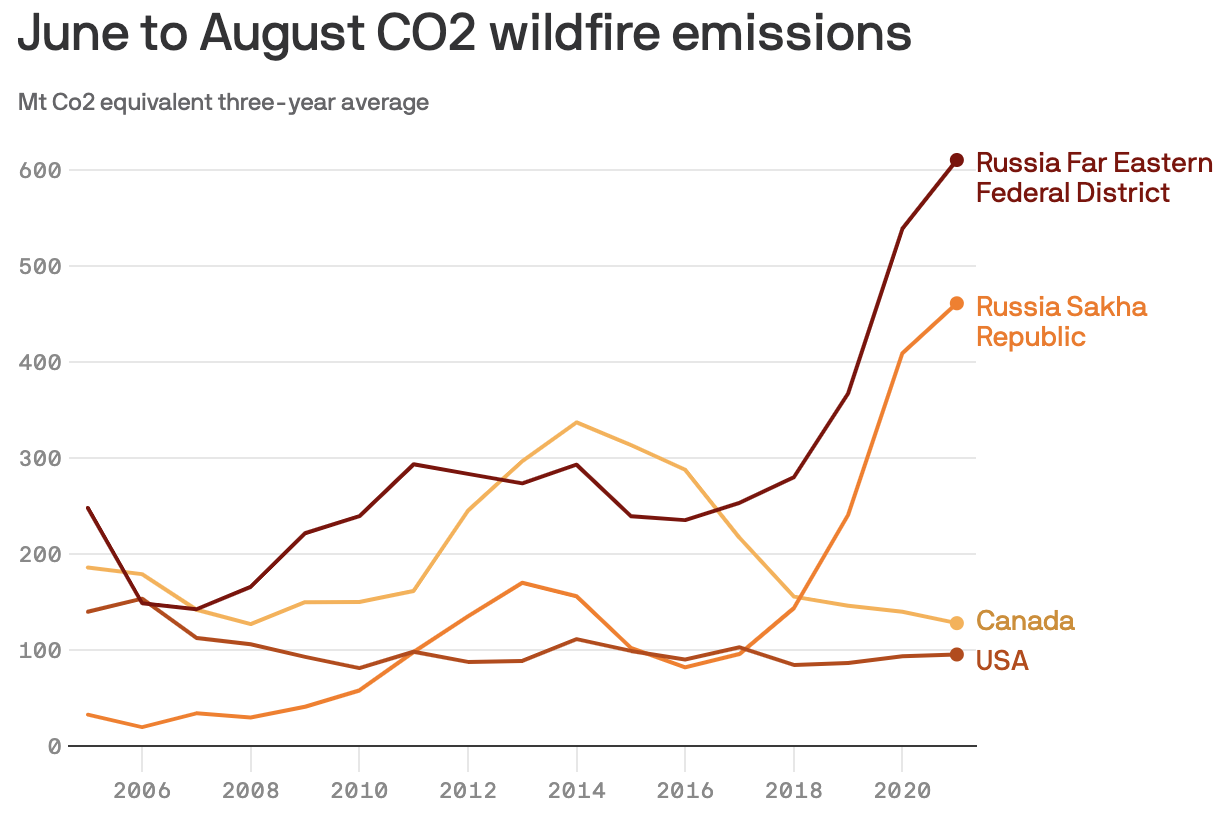Gigantic wildfires have burned across Siberia on a record scale this summer—larger than all the fires around the world combined. The massive blazes in Russia are fueled from heat waves and record droughts. These wildfires along with those in Canada and the United States are emitting carbon dioxide—a greenhouse gas—soot and other emissions. These wildfires are likely to continue to burn until the onset of winter snows and will continue to emit greenhouse gases. The Siberian fires have so far emitted about 1613 megatons of carbon dioxide equivalent gases, which is comparable to the emissions from all of Indonesia in 2019. The Sakha Republic and Far Eastern Federal District of Russia are emitting the greatest amounts of fire-related carbon dioxide emissions in Russia. Smoke from the Siberian fires has crossed the Arctic over the North Pole and into Canada.

Russian Wildfires
Greenpeace Russia estimates the fires have burned around 62,000 square miles across Russia since the start of the year. The current fires are larger than the wildfires in Greece, Turkey, Canada and the United States. Russia’s emergency services are fighting about 200 fires across the country with dozens more that are left to burn because they are not a risk to population centers. This year may be Russia’s worst fire season, passing that in 2012.
Fires have been burning since late spring in one of the worst hit regions in Russia, Yakutia–a vast semi-autonomous republic around 3,000 miles east of Moscow. An historic drought is feeding the fires, which are among the largest ever recorded. Smoke has drifted as far as Alaska and the North Pole. Local authorities are struggling to contain the fires, having only a fraction of the manpower and equipment they need. It could be the biggest fire in the recorded history of mankind, competing with several famous historic fires in the United States in the 19th century.
Local firefighters in Yakutia blame the scale of the fires on authorities’ failure to extinguish the blazes early on due to cuts to the federal forestry fire service. Yakutia’s fires have produced a record amount of carbon emissions, according to the European Union’s Copernicus satellite monitoring unit. The 505 megatons of emissions released since June would be more than Britain’s entire carbon dioxide emissions for 2019.
California Wildfires
In 2021, there have been 6,272 fires statewide in California that have burned about 1,432 square miles, according to California Department of Forestry and Fire Protection. For the same time period last year, 5,636 fires had consumed 430 square miles. The 2021 fire season may end up worse than the 2020 season, which was a record-setting year in California when 6,718 square miles burned.
More than a half-dozen major fires are blazing across Northern California due to drought on a parched landscape, record heat waves, and a forecast that includes waves of heat, wind and possibly lightning. The weather outlook is so bad experts are predicting some fires may continue to burn until late fall or early winter when rains arrive.
The Dixie Fire, California’s second-largest wildfire in modern history, has displaced thousands of people. The more than month-old wildfire has burned at least 700,630 acres, more than 1,000 square miles. The fire, which is 35 percent contained, has burned an area larger than the city of Los Angeles and destroyed at least 1,225 structures. About 16,000 structures remain threatened by the blaze. There are around 6,000 personnel helping to fight the fire.
The newest fire, the Caldor Fire, is burning in the Sierra Nevada southwest of Lake Tahoe, covering 84 square miles. The Caldor Fire hit Grizzly Flats, a town of about 1200 people. At least 50 homes burned, two people were hospitalized with serious injuries and about 5,900 homes and other structures were threatened by the fire. The Caldor and Dixie fires are among a dozen large wildfires in the northern half of California. In contrast, Southern California has had few wildfires recently.
Conclusion
The Siberian fires in Russia are emitting as many greenhouse gas emissions as individual countries do in a year, and far more than the wildfires in the United States and Canada. The United States has seen over 4 million acres burn during this year with the largest wildfires occurring in California. The Dixie Fire is the second-largest wildfire in California’s modern history. In Canada, the two provinces contributing the most fire-related carbon dioxide emissions are British Columbia and Saskatchewan. These wildfires are being propelled by drought and heat waves and suggest more attention needs to be given to firefighting personnel and equipment as well as to controlled burns.



